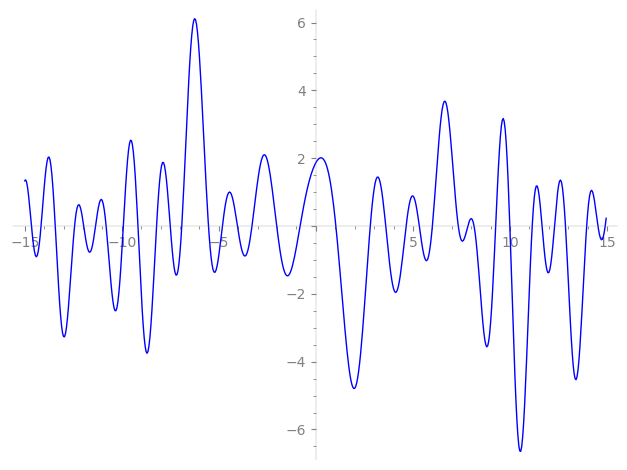| L(s) = 1 | + (0.5 − 0.866i)2-s + (−0.499 − 0.866i)4-s + (−2.23 + 0.144i)5-s + (2.37 − 1.17i)7-s − 0.999·8-s + (−0.990 + 2.00i)10-s + 0.745i·11-s + (−1.67 + 2.89i)13-s + (0.168 − 2.64i)14-s + (−0.5 + 0.866i)16-s + (4.20 + 2.42i)17-s + (6.50 − 3.75i)19-s + (1.24 + 1.86i)20-s + (0.646 + 0.372i)22-s − 1.86·23-s + ⋯ |
| L(s) = 1 | + (0.353 − 0.612i)2-s + (−0.249 − 0.433i)4-s + (−0.997 + 0.0647i)5-s + (0.896 − 0.443i)7-s − 0.353·8-s + (−0.313 + 0.633i)10-s + 0.224i·11-s + (−0.463 + 0.802i)13-s + (0.0451 − 0.705i)14-s + (−0.125 + 0.216i)16-s + (1.01 + 0.588i)17-s + (1.49 − 0.861i)19-s + (0.277 + 0.415i)20-s + (0.137 + 0.0795i)22-s − 0.389·23-s + ⋯ |
\[\begin{aligned}\Lambda(s)=\mathstrut & 1890 ^{s/2} \, \Gamma_{\C}(s) \, L(s)\cr =\mathstrut & (0.315 + 0.948i)\, \overline{\Lambda}(2-s) \end{aligned}\]
\[\begin{aligned}\Lambda(s)=\mathstrut & 1890 ^{s/2} \, \Gamma_{\C}(s+1/2) \, L(s)\cr =\mathstrut & (0.315 + 0.948i)\, \overline{\Lambda}(1-s) \end{aligned}\]
Particular Values
| \(L(1)\) |
\(\approx\) |
\(1.869700511\) |
| \(L(\frac12)\) |
\(\approx\) |
\(1.869700511\) |
| \(L(\frac{3}{2})\) |
|
not available |
| \(L(1)\) |
|
not available |
\(L(s) = \displaystyle \prod_{p} F_p(p^{-s})^{-1} \)
| $p$ | $F_p(T)$ |
|---|
| bad | 2 | \( 1 + (-0.5 + 0.866i)T \) |
| 3 | \( 1 \) |
| 5 | \( 1 + (2.23 - 0.144i)T \) |
| 7 | \( 1 + (-2.37 + 1.17i)T \) |
| good | 11 | \( 1 - 0.745iT - 11T^{2} \) |
| 13 | \( 1 + (1.67 - 2.89i)T + (-6.5 - 11.2i)T^{2} \) |
| 17 | \( 1 + (-4.20 - 2.42i)T + (8.5 + 14.7i)T^{2} \) |
| 19 | \( 1 + (-6.50 + 3.75i)T + (9.5 - 16.4i)T^{2} \) |
| 23 | \( 1 + 1.86T + 23T^{2} \) |
| 29 | \( 1 + (-0.644 + 0.371i)T + (14.5 - 25.1i)T^{2} \) |
| 31 | \( 1 + (4.33 - 2.50i)T + (15.5 - 26.8i)T^{2} \) |
| 37 | \( 1 + (-5.78 + 3.33i)T + (18.5 - 32.0i)T^{2} \) |
| 41 | \( 1 + (-0.849 + 1.47i)T + (-20.5 - 35.5i)T^{2} \) |
| 43 | \( 1 + (-7.64 + 4.41i)T + (21.5 - 37.2i)T^{2} \) |
| 47 | \( 1 + (10.0 + 5.80i)T + (23.5 + 40.7i)T^{2} \) |
| 53 | \( 1 + (-2.94 + 5.09i)T + (-26.5 - 45.8i)T^{2} \) |
| 59 | \( 1 + (-2.33 - 4.03i)T + (-29.5 + 51.0i)T^{2} \) |
| 61 | \( 1 + (1.48 + 0.856i)T + (30.5 + 52.8i)T^{2} \) |
| 67 | \( 1 + (-3.92 + 2.26i)T + (33.5 - 58.0i)T^{2} \) |
| 71 | \( 1 - 4.17iT - 71T^{2} \) |
| 73 | \( 1 + (-5.10 + 8.84i)T + (-36.5 - 63.2i)T^{2} \) |
| 79 | \( 1 + (-3.10 + 5.38i)T + (-39.5 - 68.4i)T^{2} \) |
| 83 | \( 1 + (2.26 - 1.30i)T + (41.5 - 71.8i)T^{2} \) |
| 89 | \( 1 + (-7.58 - 13.1i)T + (-44.5 + 77.0i)T^{2} \) |
| 97 | \( 1 + (2.32 + 4.01i)T + (-48.5 + 84.0i)T^{2} \) |
| show more | |
| show less | |
\(L(s) = \displaystyle\prod_p \ \prod_{j=1}^{2} (1 - \alpha_{j,p}\, p^{-s})^{-1}\)
Imaginary part of the first few zeros on the critical line
−9.166034351051697701811099312885, −8.206763474401362653858436695225, −7.50263495741495649082035691602, −6.90873241195011318698151355483, −5.53244592439052785263150678129, −4.81407797510097258272625144423, −4.04122294403592489004468117746, −3.29161798912784208692696808123, −2.01901467952663246589337370687, −0.812751713597151015114078809216,
1.02757236631431656971763332247, 2.80034917762782612677354848130, 3.59681372857382839200955110040, 4.64726474838550451895903707496, 5.32668073694394952272923697030, 5.99952099905635410552280772619, 7.33377111691562995350834412104, 7.82626368996450789982178333296, 8.145492712647373905214877339170, 9.259318605004643629718016152526

